|
| |
Weaning
Health Update: A supplement to Issue no. 32 - March 1988
pdf
 version of
this Issue version of
this Issue
|
There is much information in this issue that is valuable
and useful. Online readers are reminded, however, that treatment guidelines and health
care practices change over time. If you are in doubt, please refer to
WHO's up-to-date Dehydration Treatment
Plans.
|
Pages 1-6 Weaning
A supplement to Dialogue on Diarrhoea Online Issue
32 - March 1988
|
DDOnline Weaning
supplement to DD32  Page 1 2
Page 1 2
HEALTH BASICS: WEANING
Breastmilk is the best and safest food for young babies. Older babies need extra foods
as well as breastmilk. It is important that babies are given extra foods as well as
breastmilk at the right age, and in sufficient amounts, to enable them to grow and stay
healthy. Too little food, given too late, or inadequate food with too few nutrients may
lead to poor growth and malnutrition. The malnourished child will get sick more often and
will be less able to fight off illnesses such as diarrhoea. Weaning foods can, however, be
very dangerous for babies. If they are not hygienically prepared they can be a major
source of infection. This Health Basics insert describes good weaning practices to help
families prevent diarrhoea in their children. What is weaning? Weaning means giving family foods in addition to breastmilk. Weaning is a gradual
process by which the infant becomes accustomed to the adult diet.
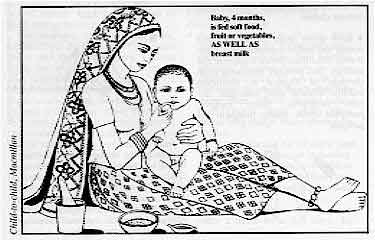 |
Baby, 4 months, is fed soft food, fruit or vegetables, AS
WELL AS breastmilk It is not good for babies to stop giving breastmilk when new foods are first being
given - weaning foods do not replace breastmilk, they complement it. As the baby gets
older it needs more food to grow and stay healthy.
|
The number of breastfeeds can be reduced slowly as the baby starts to eat more and more
family foods. However, it is important to remember that until the age of about two years
babies can still receive an important amount of nourishment from breastmilk. When to start giving extra foods?
|
Baby, 9 months, eats mashed food Weaning foods should be given to the baby at about the age of four to six months. At
four months most babies start to need extra food in addition to breastmilk because they
are growing fast and breastmilk is no longer enough.
|
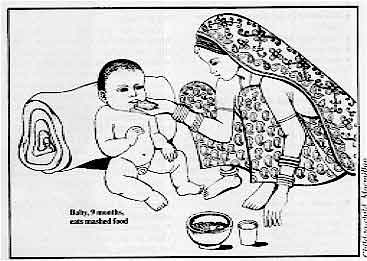 |
How should weaning foods be given, and how often? Start by giving one or two teaspoons a day of carefully mashed food in addition to
regular breastfeeds. Do not use a feeding bottle. Slowly increase the number of meals and
the amount of food given. By the age of eight months most babies need four 'meals' a day
including a variety of foods, in addition to regular breastfeeding. At one year old a
child should be able to be given all types of family foods, although the food may still
need to be softened or mashed. At this age a child needs to eat about half the daily
amount of food its mother eats. Feed babies using a clean cup and spoon. Do not add water to the weaning food. Watered
down weaning food does not have enough nutritional value, and if the water is dirty or
contaminated the baby will probably get diarrhoea. Patience is needed when babies are
first starting to eat family foods - while they are learning to eat this way they may
often spit out the food - this does not mean that they are not hungry. Let the baby get
used to one food for a few days before introducing another. Weaning foods should ideally be:
- high in energy;
- easy to digest;
- low in bulk and viscosity (not too thick);
- fresh and clean;
- inexpensive and easy to prepare;
- not too highly seasoned.
|
|
DDOnline Weaning
supplement to DD32  1 Page 2 3 1 Page 2 3
What are good weaning foods? A thick creamy porridge made from the basic food of the community is a good weaning
food for babies. The basic food or staple is cheaper than most other foods and is usually
eaten by the family at most meals. Examples of basic foods include:
- cereals
- maize
- wheat
- sorghum
- oats
- barley
- bread (soaked in gravy, milk, or tea)
- rice
- roots
- cassava
- yam
- cocoyam
- potato
- sweet potato
- starchy fruits
- plantain
- breadfruit
- banana
|
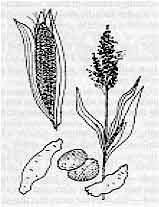
|
|
 |
On their own, especially when cooked in water, most cereals, grains and roots are too
low in energy. Some oil or fat (or sugar) should be added to the porridge to make it
richer and easier to swallow and digest. Adding oil increases the energy value of the
weaning porridge. Give this porridge in addition to breastmilk for about two weeks - after this time
babies need other foods as well as breastmilk and porridge to provide enough energy and a
balanced diet. It is important that weaning foods contain oils, fats or sugars; fruits;
dark green vegetables or orange or yellow fruits; and food from animals or fish or from
legumes (for example lentils). These different types of food provide energy; vitamins; and
proteins. The best type of weaning meals should contain something from all of these
groups. Continue to give breastfeeds regularly between meals. Examples of types of foods from these groups are:
- peas and beans
These are as good as food from animals for providing protein but are cheaper. They need to
be cooked thoroughly and mashed to make them easily digestible for babies. Examples
include chickpeas, cowpeas. groundnuts, soya beans, split peas, lentils, blackeye beans,
peanuts, red beans, navy beans.
- food from animals and fish
These are good for babies but are usually more expensive than peas and beans. Examples
include meat, fish, offal. eggs, milk. and food made from milk such as cheese and
yoghurt,
curd. cottage cheese.
- dark green leafy vegetables, and orange and yellow
vegetables and fruits
Babies need these foods to prevent eye damage and possibly blindness from shortage of
Vitamin A. Examples include: spinach, kale, tomatoes, carrots, amaranth, sweet cassava,
pumpkin leaves, calalu, pumpkin and pawpaw.
|
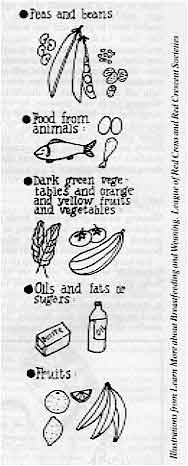 |
- oils, fats or sugars
These add extra energy to the weaning porridge or cereal dishes. Sugars are not as good as
oils or fats and will also damage teeth. Examples include: corn, palm, groundnut, coconut
and sunflower oils, ghee, butter, margarine, lard, any animal fat.
- fruits
Before giving these to babies they should be peeled carefully or washed in clean water.
then mashed or the juice squeezed out. If water is added to the juice it must be clean;
otherwise babies may get diarrhoea. Examples include: oranges, pumpkin, tomato. banana,
papaya. mango, pineapple.
|
|
DDOnline Weaning
supplement to DD32  2 Page 3 4 2 Page 3 4
Food from the family pot
 |
Family
foods, that is foods that the rest of the family normally eat can give babies all the
nourishment they need without any additional cost. There is no need to buy expensive
commercially manufactured weaning foods. |
Talk to mothers about what the family usually eats and help them to decide which foods
would be suitable to give a young baby. Family pot feeding - giving the family food in a
mashed form, without or before adding hot spices or extra salt, and adding something extra
like oil, an egg, and extra dark leafy vegetables - is best. Put the child's food in a
separate dish or bowl so that it is possible to see how much he or she eats. Also make
sure that the bowl or plate and utensils used by the child are clean. This also encourages
the child, as it gets older to learn to feed itself. Make sure that the child's hands are
clean. Cooking weaning foods Cooking equipment, particularly stoves, plays a vital role in the health of the family
or community. Safe, economical stoves are essential to provide heat and light and to cook
safe and nutritious meals. A good cooking stove helps to ensure that weaning foods are well cooked and properly
reheated. A stove should be:
- safe (so that children do not burn or scald themselves);
- easy to use and suitable for frequent use;
- fuel efficient, i.e. should not waste or use too much fuel, or produce too much smoke:
- be capable of cooking and reheating food thoroughly and boiling water using minimal fuel
and time.
Food that has not been cooked or reheated thoroughly may contain diarrhoea-causing
germs (pathogens). Cooking food thoroughly so that it boils can make it safe by destroying
these pathogens (e.g. bacteria and parasitic eggs). Cooking food can also improve its
flavour, making it more palatable for children, and the addition of other ingredients can
increase the nutritional value of the food. (Badly or over-cooked food on the other hand
can cause loss of nutrients and contribute to malnutrition). Cooking food also makes it
easier to chew and digest and helps the body to absorb nutrients from it. Preparing weaning foods
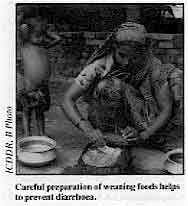 |
Careful preparation of weaning foods helps to prevent diarrhoea.
Contaminated weaning foods give babies diarrhoea. Careful preparation and storage of
weaning foods keeps them safe.
|
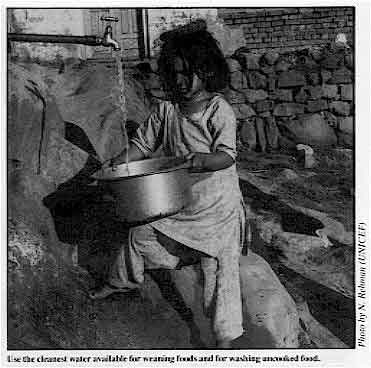
Use the cleanest water available
for weaning foods and for washing uncooked food.
Follow these rules for safe preparation of weaning foods:
- wash hands before preparing food:
- if possible prepare weaning foods immediately before they will be eaten;
- wash all utensils before preparing food, and scrub chopping boards and tables;
- cook or boil food well;
- reheat food thoroughly if it has been kept for more than two hours, until it boils.
Boiling food will kill any germs that may have contaminated the food while it has been
stored. Let it cool before giving it to the baby;
- mash foods up with a clean pestle, fork or spoon. Never use a sieve as these are
difficult to keep clean;
- use the cleanest water available for making weaning foods and for washing uncooked
foods. If possible boil the water if it has not come from a clean source such as a tap or
water pump. Boiling water will kill the germs that cause diarrhoea.
|
|
DDOnline Weaning
supplement to DD32  3 Page 4 5 3 Page 4 5
Storing weaning foods
|
Keep food in a cool shady place.
- Do not store weaning foods for more than two hours if possible. Keep them stored in
clean covered containers that keep out flies and other insects.
- Keep in a cool shady place out of direct sunlight if possible.
- If food has been kept for more than two hours reheat it thoroughly so that it boils.
|
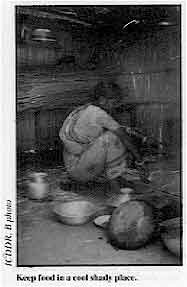 |
Personal hygiene and weaning foods Hands should be washed before preparing weaning foods and before feeding them to the
baby, particularly after using the latrine. Unwashed hands can pass on diarrhoea germs via
food to the baby. Mothers should be especially careful to wash their hands, with soap if
available, after cleaning their baby's bottom. Remember:
| cool, covered, clean cooked
food is safe food but faeces, flies, filth, fingers can mean dirty unsafe
food.
|
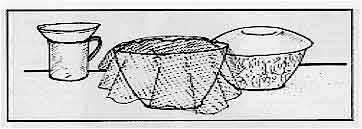 |
Why do weaning age babies get malnourished? This is usually because:
- they are not given the right sort of weaning foods or enough food;
- they grow very fast and need plenty of energy rich foods - more for their size than
older children or adults;
- they may be taken off the breast too early, or suddenly, i.e. as soon as extra foods are
given;
- they have small stomachs and do not get food often enough. Two or three meals a day like
the rest of the family is not enough for the weaning age baby;
- they do not have enough teeth to chew, and need food that is soft and easy to swallow.
Why do weaning age babies often get diarrhoea?
- After four to six months of age babies have lost some of the protection against disease
given to them by their mothers at birth (maternal antibody) and from
breastmilk.
|
Hands
should be washed before preparing weaning foods.
- They may also get diarrhoea from the new foods that they are being given if these are
prepared or given to the baby with dirty hands and utensils. Food that is not stored
safely, but which is left uncovered and open to dirt and flies, or kept in dirty
containers, will quickly go bad, become contaminated and may give babies diarrhoea.
- Also at this age babies start to move around more, put things in their mouths, and are
more likely to come into contact with germs and dirt. However, they are too young to have
built up much immunity themselves to protect them against diseases such as diarrhoea.
|
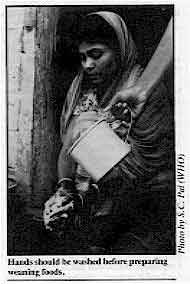 |
The weanling with diarrhoea As at any other age, the weanling with diarrhoea must be given plenty of appropriate
fluids and continue to eat plenty of nourishing food to help recovery and ensure that
there is no growth retardation. Weaning education Before talking to mothers about which weaning foods to give, you will need to be aware
of the family's socio-economic status, and availability of different types of foods,
particularly those which are seasonal. Some existing beliefs about foods and feeding are
beneficial, others may be more harmful, but make suggestions tactfully and explain how a
weaning diet can be made more nutritious using local foods. In many places you may also
need to win over the support of the grandmother if you are to change what mothers feed to
their young children. For example, there are, in India, beliefs about the digestibility of certain foods and
their consistency. Far too often watery gruels or lentil water or thin vegetable soups are
given in the belief that the baby will not be able to digest anything else. But these have
no or very little energy value. Beliefs in 'hot' and 'cold' foods or, for example, that
cereals are bad for the liver, should not be condemned, but can be overcome with patience
and alternatives suggested. Many mothers believe that their baby needs expensive or
special foods, which they cannot afford. They may also ask how the child can eat proper
food before it has any teeth. Emphasise that this is not a problem if the food is properly
mashed and soft.
|
|
DDOnline Weaning
supplement to DD32  4 Page 5 6 4 Page 5 6
Feeding the weaning child
|
Remember that no two babies are the same in which foods they like more
than others.
Points to remember
- Feeding is a matter of using good sense. Like adults, babies may like a particular food
more than another, and may be more hungry on some days than others. No two babies are the
same in which foods they like more than others. Some babies prefer sweet things while
others prefer salty things. Make allowances for this.
|
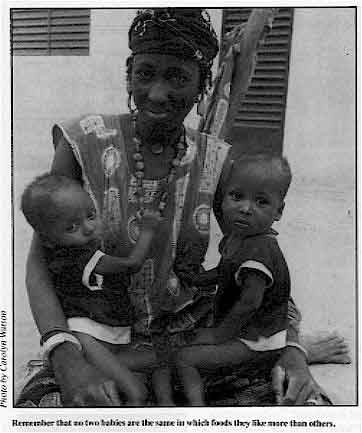 |
- Mealtimes should be pleasant and 'force' must not be used in feeding. Remember that
learning to swallow semi-solid food may be difficult for a baby who only knows how to suck
the breast.
- If a particular food is refused, do not offer it again for a few days. Try something
different.
|
Home and community weaning food production This can be done:
- at home using a cereal staple plus legume/seed/nut mixture. The mixture should be easily
reconstituted and should have a shelf life of at least one week (simple grinding devices
to reduce the time and work involved are recommended); or
- at community level through community groups. Women's groups can initiate and operate
communal production/income generating activities which may or may not be subsidised. The
use of oils, pineapple juice, papaya juice and fermentation methods as welt as germination
can decrease the viscosity of weaning foods. Community level activities should have an
educational and health component and should be integrated into, for example, children's
supplementary feeding programmes.
- There are several approaches to decreasing the viscosity and bulk of weaning food.
Fermenting sorghum produces enzymes which decrease viscosity, as used in Tanzania. In
South India, fermentation of rice and legumes is used to decrease viscosity. With bulky
staple foods common in Asia and Africa, a small child would have to consume about 1
kilogramme of cooked rice or cooked banana to obtain only 1,000 calories. Small children
cannot cope with such enormous quantities of staple foods to meet their energy needs. More
energy dense, less bulky, low viscosity foods for young children should be promoted.
|
Acknowledgements This DD insert is based on an article by Dr Shanti Ghosh
and material from:
- Learn More About Breastfeeding and Weaning.
League of Red Cross and Red Crescent Societies 1987.
- Primary Health Care Technologies at Family and
Community Levels. Aga Khan Foundation. UNICEF. WHO. 1986.
- Feeding Mother and Child. The Caribbean Food and
Nutrition lnstitute.
- Prevention of Diarrhoea. Supervisory Skills. WHO.
1987.
|
|
DDOnline Weaning
supplement to DD32  5 Page 6 5 Page 6
Addresses for organisations supplying books/manuals, audiovisuals,
and newsletters, are listed under sources of information and materials. SOURCES OF INFORMATION AND MATERIALS
- American Public Health Association, International Health Programmes, 1015
Fifteenth Street, N. W., Washington, D. C. 20005, USA.
- Caribbean Food & Nutrition Institute, PO Box 140, Kingston 7, Jamaica.
- Child-to-child Programme, Rm 833, Institute of Education, 20 Bedford Way, London
WC1 0AL. UK.
- Clearinghouse on Infant Feeding & Maternal Nutrition, American Public Health
Association, 1015 Fifteenth Street, N. W. Washington, DC 20005, USA.
- Find Your Feet, 13-15 Frognal, London NW3. UK.
- Intermediate Technology Publications Ltd., 103-105 Southampton Row, London WC1B
4HH. UK.
- International Nutrition Communication Service (INCS), Education Development
Centre, 55 Chapel Street, Newton, MA. 02160, USA.
- Institute of Nutrition & Food Sciences, University of Dhaka, Dhaka 2,
Bangladesh.
- International Children's Centre, Chateau de Longchamp, Bois de Boulogne, F75016,
Paris, France.
- League of Red Cross & Red Crescent Societies, 17 Chemin des
Crêts, P. O. Box
372, 1211 Geneva 19, Switzerland.
- London School of Hygiene & Tropical Medicine, Department of Human Nutrition,
Keppel Street, London WC1 7HT. UK.
- Macmillan Press Ltd., Houndmills, Basingstoke, Hampshire RG21 2XS. UK.
- National Food & Nutrition Committee, PO Box 2223, Government Buildings, Suva,
Fiji.
- Nutrition Foundation of India, B 37 Gulmoher Park, New Delhi, India.
- Nutrition Foundation of the Philippines, Inc., 107 E, Rodriguez Sr., Boulevard,
Quezon City, PO Box 3, Philippines.
- National Institute of Nutrition, Indian Council of Medical Research, Hyderabad
500 007, India.
- Ministry of Health, Nutrition Section, Box 2084,
Konedobu, Papua New Guinea.
- Oxford University Press, Walton Street, Oxford OX2 6DP.
- Teaching Aids at Low Cost (TALC), PO Box 49, St. Albans, Herts. AL1 4AX.
- Tanzania Food & Nutrition Centre, Box 977, Dar es Salaam, Tanzania.
- UNESCO, Nutrition Education Programme, 7 Place de
Fontenoy,
75700. Paris, France.
- UNICEF, UN Plaza, 4/1234C, New York 10017, USA.
- Urban Resource Systems, 783 Buena Vista West, San Francisco, CA 94117, USA.
- Voluntary Health Association of India (VHAI), 40 Institutional Area, South of
IIT, New Delhi, 110 016, India.
- World Health Organisation (WHO), Nutrition Unit, 1211 Geneva 27, Switzerland.
- World Federation of Public Health Associations (c/o American
Public Health Association, USA)
- World Neighbors, 5116 North Portland Ave, Oklahoma City, OK 73112, USA.
BOOKS/MANUALS Cameron M & Hofvander Y. Manual on Feeding Infants and Young Children. Oxford
University press. 1983
Child-to-child Programme. Child-to-child Reader: Good Food.
Caribbean Food & Nutrition Institute (CFNI). A Guide to Feeding the Weaning Age
Group in the Caribbean. 1982 and Improving Weaning Practices in the Caribbean. Self
Learning Modules for Community Workers. 1986.
Ebrahim G. J. Nutrition in Mother and Child Health. Macmillan. 1983.
Ghosh S. The Feeding and Care of Infants and Young Children. Voluntary Health
Association of India (VHAI). 1985.
Hollis C. Using Communications To Solve Nutrition Problems. International
Nutrition Communication Service. (INCS) 1986.
Israel R., & Lamptey P. Nutrition Training Manual Catalogue for Health
Professionals, Trainers and Field Workers in Developing Countries. (INCS).
Joint WHO/UNICEF Nutrition Support Programme. UNSP Nutrition Learning Packages,
Package 4: Young Child Feeding.
League of Red Cross & Red Crescent Societies. Learn More About Breast Feeding
& Weaning. 1987.
Nutrition Handbook for Community Workers in the Tropics. Macmillan/CFNI. TALC.
UK. 1986.
Pacey A. Gardening for Better Nutrition. Intermediate Technology Publications.
1978.
Proceedings First Asian Household Nutrition Appropriate Technology Conference. Colombo,
Sri Lanka. UNICEF 1981.
Ritchie J. A. S. Nutrition & Families. Macmillan. 1983.
Royal Tropical Institute, Mauritskade 63, 1092 AD Amsterdam, The Netherlands. Ready-made
Weaning Food Mixtures in Developing Countries. 1983.
De Sweemer C., et al Manual for Child Nutrition in Rural India. VHAI.
Tregoning M. A., & Bova G. S. Better Child Care. TALC, UK.
UNESCO, Nutrition Education Series. Issue 10. Easy to Make Teaching Aids for
Nutrition Teaching Learning. 1984.
UNICEF The UNICEF Home Gardens Handbook - For People Promoting Mixed Gardening in
the Humid Tropics.
Wade I. City Food Crop Selection in Third World Cities. Urban Resource Systems.
1986.
World Federation of Public Health Associations. Programmes Activities for Improving
Weaning Practices. Information for Action Issue Paper. 1984.
WHO. Guidelines for Training Community Health Workers in Nutrition. WHO Offset
Publication. 2nd Edition, 1986.
Nutrition Educational Materials Listing. WHO. 1984.
Show and Tell. Nutritional Educational Programme. UNESCO. 1985.
AUDIOVISUALS Videos
- How to Wean Your Baby. A 20 minute video cassette & slide/audio cassette.
1986. CFNI.
- Lucky Gary. A 10 minute video on weaning aimed at eastern Caribbean audiences.
CFNI.
Slides
- Weaning Foods & Energy. TALC, UK.
Filmstrips
- Filmstrips available on feeding babies suitable for audiences in Guatemala, Nepal,
Philippines. World Neighbors, USA.
Flipchart
- Infant Care & Feeding. World Neighbors, USA.
Flannelgraph
- Series includes: Feed Your Children Often, Give Your Child Plenty of Soup.
TALC, UK.
NEWSLETTERS Bulletin of the Nutrition Foundation of the Philippines. Nutrition Foundation of
the Philippines. Bi-monthly, English & Tagalog, Subscription.
Cajanus Magazine, Caribbean Food & Nutrition Institute. Quarterly,
English, Subscription.
The Fiji Food & Nutrition Newsletter, The National Food & Nutrition
Committee. Fiji, English, Subscription.
Nutrition, Division of Nutritional Sciences, Cornell University, USA. English,
Free.
Nutrition & Development. Ministry of Health, Papua New Guinea. Quarterly,
English, Subscription.
Nutrition News. National Institute of Nutrition, India. English, Free.
Nutrition News, Institute of Nutrition and food sciences, Bangladesh. Quarterly,
English, Subscription.
Mothers & Children. American Public Health Association. English, French,
Spanish, Free.
Tanzanian Food & Nutrition Journal. Tanzanian Food & Nutrition Centre,
Tanzania. English, Subscription.
Vitamin A + Sieve, Rodale Press Information Services, 33E, Minor Street, Emmaus,
PA 18098, U.S.A. English, Free.
Xerophthalmia Club Bulletin. 31 Observatory Street, Oxford, U. K. English,
Free.
|
Weaning
Health Update - A supplement to Issue no. 32 March 1988
Page Navigation
This edition of Dialogue on Diarrhoea Online is
produced by Rehydration Project.
Dialogue on Diarrhoea was published four times a year in English,
Chinese, French, Portuguese, Spanish, Tamil, English/Urdu and Vietnamese and
reached more than a quarter of a million readers worldwide.
The
English edition of Dialogue on Diarrhoea was produced and distributed by
Healthlink
Worldwide.
Healthlink Worldwide is committed to strengthening primary health care and
community-based rehabilitation in the South by maximising the use and impact
of information, providing training and resources, and actively supporting
the capacity building of partner organisations. - ISSN 0950-0235 Reproducing articles
Healthlink Worldwide encourages the reproduction of
articles in this newsletter for non-profit making and educational uses. Please
clearly credit Healthlink Worldwide as the source and, if possible, send us a copy of any
uses made of the material.
|
updated: 23 August, 2019
|
version of this Issue